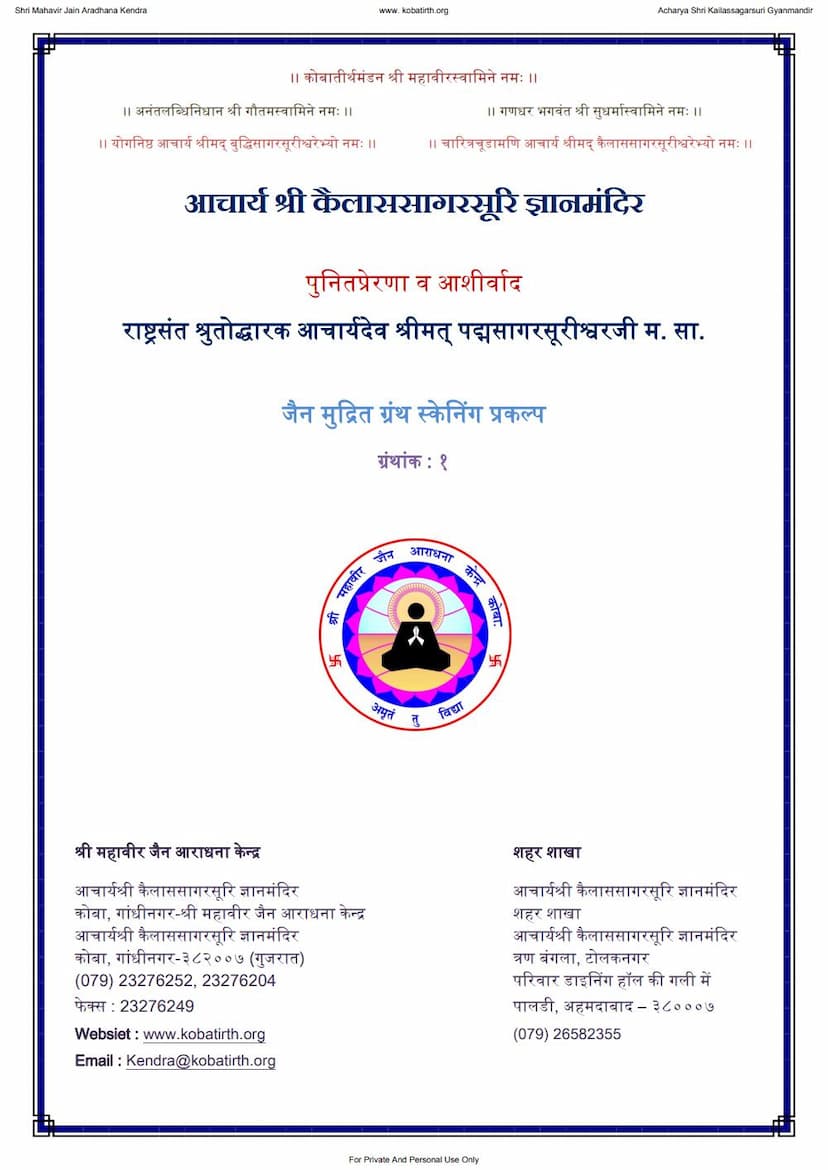Agam 31 Prakirnaka 08 Ganivijja Sutra Shwetambar
Added to library: September 1, 2025

Summary
This document is an excerpt from Agam 31 Prakirnaka 08 Ganivijja Sutra, part of the Shwetambar Jain Agamas, authored by Purnachandrasagar and published by Jainanand Prakashan. The document is specifically presented by Shri Mahavir Jain Aradhana Kendra, Acharya Shri Kailassagarsuri Gyanmandir.
The core of the document is the Ganivijja Sutra itself, which appears to be a treatise on auspicious and inauspicious timings and events, likely related to determining the suitability of certain actions or journeys. The text uses Prakrit language, as is common in Jain Agamas.
However, a significant portion of the provided text consists of extensive prefaces and historical accounts related to the preservation and revival of Jain Agamas. These sections provide valuable context:
-
Introduction to the Text and its Significance: The text begins by praising the importance of Shrutgyan (scriptural knowledge) as a guiding light for beings in the cycle of rebirth. It emphasizes that the Agamas are the words of Lord Mahavir.
-
History of Agama Compilation and Recensions (Vachanas): A substantial part of the document details the historical efforts to compile and preserve the Jain Agamas through a series of six major "Vachanas" (recensions or assemblies) over a period of about 1000 years after Lord Mahavir's Nirvana.
- First Vachana (Shrut-Sankalan): Occurred around Vir Nirvana Samvat (VNS) 160 in Pataliputra (Patna) under the presidentship of Shri Sthulabhadra, due to a severe famine and scattering of monks.
- Second Vachana (Agam Sanrakshan Vachana): Took place in Ujjain under Arya Suhasti Suri, with the patronage of Emperor Samprati, to address deficiencies in recitation and teaching.
- Third Vachana: Occurred during the time of Emperor Pushyamitra's persecution, where monks fled to Kalinga. It involved a large assembly of monks and nuns, and the compilation of eleven Angas and ten Purvas.
- Fourth Vachana: Held in Dashpur (Mandsaur) around VNS 592 by Shri Vajraswami, who foresaw a severe famine and instructed his disciple Arya Rakshit Suri to organize the Agamas into four Anuyogas for their longevity.
- Fifth Vachana: Took place around VNS 830-840 in Mathura and Vallabhi, with different groups of monks compiling the Agamas separately due to prevailing chaos, with the aim of future reconciliation of textual differences.
- Sixth Vachana: The final major recension, conducted by Arya Devarddhigani Kshamashraman and Arya Kalkacharya in Vallabhi (Saurashtra) around VNS 1000. This is considered the most significant as it systematically compiled the 84 Agamas and recorded them on palm leaves, making them into book form. This period is also noted as the time when the direct lineage of full knowledge might have faced a break.
-
Decline and Revival Efforts: The text laments the decline of knowledge and the scarcity of Agamas due to adverse times and the erosion of strict adherence to principles from the 10th century onwards. It highlights the efforts of the "Sagar Shakh" of the Shraman Sangh, particularly emphasizing the work of Acharya Shri Anandasagar Surishwarji Maharaj (also known as "Pujya Sagarji M."). He is credited with significant efforts in the 20th century to research, edit, and publish the Agamas, organizing communal recitations and inspiring others like Muni Shri Punyavijayji M. to continue this vital work.
-
The Current Publication: The present publication of the Ganivijja Sutra is stated to be based on the research and editing done by the aforementioned Acharya Shri Anandasagar Surishwarji Maharaj. The publication is made by Jain Anand Library, Surat, an institution established by "Pujya Sagarji M.".
-
The Ganivijja Sutra Content (Partial): The latter part of the document presents verses from the Ganivijja Sutra. These verses seem to discuss:
- The importance of understanding strength and weakness (Balabalavidhi).
- The auspiciousness of days, constellations (Nakshatras), lunar days (Tithis), and specific timings (Muhurtas).
- The influence of planetary positions and their effects on undertakings.
- Specific guidelines for starting journeys, rituals, and austerities based on constellations and their timings.
- The classification of constellations based on their nature (e.g., quick-acting, slow-acting).
- The significance of various celestial phenomena and omens.
In summary, the document presents the Ganivijja Sutra, a Jain text dealing with auspicious timings, within the broader context of the historical preservation and revival of the Jain Agamas. It highlights the arduous journey of these sacred texts through centuries of societal changes and the dedicated efforts of various acharyas, particularly Acharya Shri Anandasagar Surishwarji Maharaj, in ensuring their continued availability and study. The Ganivijja Sutra itself provides practical guidance for adherents on when to undertake specific actions to ensure success and avoid misfortune.